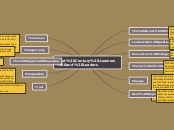21st Century Learners and Leaders
The Growth Mindset
Selecting the "right drivers" to make change happen. Regarding errors as opportunities for growth is what successful leaders do.
Leadership Qualities
Lifelong learner, personal persistence, resilient, builders of social capital
Innovative Pedagogy
developing students critical literacy through innovative pedagogy
Theory of Action
1) Capacity Building Focused on Results 2) Learning in Context 3) Professional Learning Communities 4) Lateral Capacity Building 5) De-privatization Precision 6) System Identity 7) Transparency
Change
While exploring the fear of change: get the fear out in the open, create and rovide non-risk atmospheres and work through the new learning environment in small doses. Completing this process- see the new possibilities for success and be willing to take more risks.
Next Steps
Good leadership examples need to be captured and shared, at all three levels of leadership: school, district, and ministry levels
Teamness
Social Capital: mentorship between experienced and novice teachers. For large-scale cultural change, leaders need to support, facilitate and maintain collaborative relationships
Transparency
To uncover what is positively impacting students: monitor transparency of practice and results
The Digital Dimension
Teachers and students are required to engage as innovative co-learners.
Principalship
Principals play a critical role in creating successful schools- ensure that the quality of teaching and learning opportunities are being supported in the school, less focus on the politics of the school system.
Trust
The single largest condition for success in education- fostered through behaviours.
